Quick Tip: Discover how a yoga wheel can enhance flexibility, alleviate back pain, and strengthen your body through various poses.
Yoga wheels are the trendiest new yoga prop with so many benefits for beginner and advanced yogis alike. A yoga wheel can help improve your flexibility, reduce back pain, and build strength.
Of all the yoga props out there, the yoga wheel is probably the most versatile and beginner-friendly. This is probably why yoga wheels have gotten so popular.
But how the heck do you use a yoga wheel in your yoga practice? What poses can be modified with a wheel? And what are the benefits of a yoga wheel anyway?
Let’s dig into the details of this innovative yoga prop, including why and how to use a yoga wheel, the best yoga wheels on the market, and our favorite yoga exercises with a yoga wheel!
Prefer Video? Here’s one on Yoga Wheel:
What is a Yoga Wheel?
A yoga wheel is simply a hollow circular-shaped prop made of cork, plastic, or wood. It is used to enhance your yoga practice and support your body in backbends, workouts, and restorative poses.
The amazing thing about this simple cylindrical tool is that it can benefit anyone, whether you’ve done yoga for decades or are just getting started. The wheel can be used as a simple massage roller or passive stretching device. It is often used off the mat as a fitness accessory as well.
Yoga wheels come in multiple sizes for different body types and uses. Mini yoga wheels are particularly nice for beginners who don’t want to go as deeply into backbend postures or who prefer a milder massage.
Larger wheels are ideal for taller yogis or advanced yogis who like deep heart-opening backbends. Regardless of the size, targeted yoga wheel exercises can help you reach your fitness and yoga goals faster.
Benefits of a Yoga Wheel
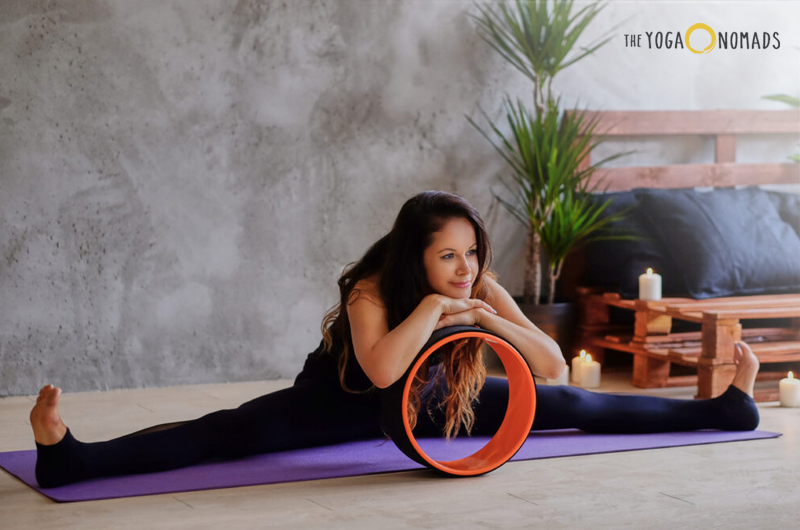

The female is stretching her body on a floor in a restroom.
As people come up with unique new ways to use the yoga wheel, the list of potential benefits continues to expand. A yoga wheel can help release tension in anyone with back pain. It also helps to gently open up tight muscles in the shoulders, abs, chest, and hip flexors.
Yoga wheels help:
- Increase flexibility
- Back pain relief
- Support Backbends
- Improve balance
- Build strength
Increase Flexibility
Whether you are gently holding the wheel between your hands in Child’s Pose or you are full-on laying back on a yoga wheel during Fish Pose, this prop dramatically improves flexibility- but in a gentle way.
Because it provides a solid yet comfortable support, a yoga wheel gives you the deep stretch you crave without the risk of going too far and hurting yourself. The yoga wheel can give you a deeper stretch or a more mild stretch depending on how you use it.
For example, for a deeper stretch in Child’s Pose, you can use the wheel as a higher surface for your hands. By dropping your head between your biceps and opening between the shoulder blades, you get a deeper upper-body stretch.
On the flip side, if you want to increase flexibility without too much intensity, you can use a small wheel underneath your shoulder blades during a gently reclined Fish Pose. Gentle heart-opening poses like this are perfect yoga wheel exercises for beginners.
Thanks to its balanced cylindrical design that flows with the body’s natural curves, the wheel keeps you in proper alignment as you lengthen and stretch.
Back Pain Relief
Pretty much everyone has some sort of back pain these days thanks to our sedentary lifestyles and hunching over devices. Back pain is the most common reason most people begin yoga in the first place (before they discover all the other amazing mental and physical benefits). But these rolling yoga props just took back relief to a whole different level.
A yoga wheel is one of the most affordable and simple forms of back pain relief you’ll find, whether on or off the mat. It’s like a free self-administered spinal massage that you can use at any time. By simply rolling the wheel along your spine, you get a gentle massage that relieves tension and supports spinal decompression.
Simply lay down and place the wheel under your back at the base of your spine. Prop yourself up onto the yoga wheel and use your legs to gently roll back and forth, allowing the wheel to roll down to your tailbone and then back up to the base of your neck.
Depending on your flexibility and the size of the wheel, you can make adjustments as needed. You will recognize how important it is to have a supportive yet cushioned yoga wheel that won’t be too harsh on your vertebrate.
This rolling motion helps release tension, improve blood circulation, and warm up those tight back muscles before your yoga practice. You can do the same roller movement on your legs and hips for a similar effect.
Backbend Support
There’s no denying that backbends are super intimidating for beginner yogis! These wheel-shaped props make backbends so much more accessible by adding support and preventing you from extending farther than you’d like. A larger wheel offers a deeper stretch, whereas mini yoga wheels offer a more mild spinal extension.
The yoga wheel acts like a scaffold of support to prevent injuries while still allowing you the heart-opening relief of a full backbend. Honestly, I may not have been able to perform backbends after my back injury if it wasn’t for a yoga wheel. The cylindrical shape is so simple yet supportive and acts like an exercise ball, but more firm and versatile.
Improve Balance
As you work on more challenging balancing asanas like Crow Pose, you’ll find that a yoga wheel is a secret weapon that you’ve always dreamed of. You can still practice proper form by flexing your core and holding the arm balance, but you have the yoga wheel to support your shins or toes. We’ll explain more about the wheel-assisted Crow Pose below.
In standing poses like Half Moon, a yoga wheel comes in handy simply because it is taller than a block and can be used as a balancing mechanism beneath one arm. The added support helps in stabilizing muscles and allowing you to perfect your form.
You can also practice balancing just by standing on top of a yoga wheel. Some yogis like to practice Garland Pose (Malasana) while balancing on top of a yoga wheel, which is a little easier on the inner thighs because your feet are gripping the circular wheel.
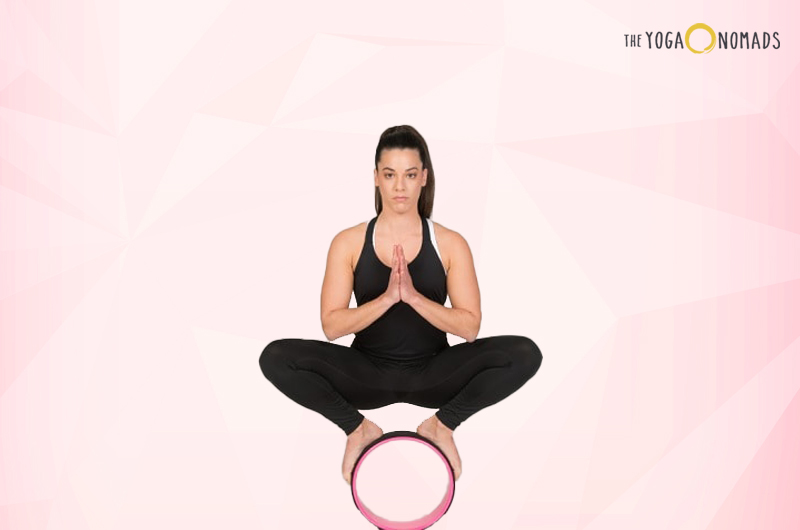

Build Strength
If you want to make your yoga practice a little more challenging and strength-building, a yoga wheel can do that as well! Using the wheel in core exercises and planks adds some major burn to your practice. The wheel also makes yoga poses more active and dynamic for more muscle building and cardio.
Top 3 Best Yoga Wheels
While there are lots of yoga wheels on the market (we reviewed them here), they aren’t all created equal! Some yoga wheels will bend and flex under your weight and not last very long. Others may be too firm and rough on the spine.
We tested out the best and found that the UpCircle Seven Yoga Wheel takes the cake for the most popular and versatile option, but the Inviguri Cork Back Roller is the most sustainable plastic-free yoga wheel.
However, if you are looking for some major physical therapy and spinal relief, Plexus Chirp is specifically designed for those with arthritis and herniated discs. It is also clinically approved by chiropractors and physical therapists.
Most Popular Yoga Wheel: UpCircle Seven Yoga Wheel
UpCircle Seven has become the most iconic yoga wheel thanks to its affordability, functionality, and durability. This padded ABS plastic roller offers incredible back massaging capabilities and is weight-rated up to 550 lbs!
Best Cork Option: Inviguri Back Roller Yoga Wheel
Inviguri Roller Yoga Wheel with Spinal Groove, Cork Wheel for Stretching and Muscle Pain Release,…
- The Right Intensity for Your Level – Whether you are a newbie to stretching or a yoga master, our back roller wheel has the right size for you! This yoga back roller comes in 2 sizes. Each variation caters to your training needs, offering different levels of firmness and pressure.
- Eases Neck and Back Pain more effectively than a traditional foam roller – Relax and release tension in your back and neck. Our back stretching wheel releases muscle strain by realigning the natural curvature of your spine. It features a spinal groove technology for less spinal pressure and for moderate to intense pressure on the erector muscles.
If you’re looking for a plastic-free, sustainable option, the Inviguri back roller is by far the best we’ve found. It is dense and durable, rated for 500 lbs (larger wheel size), and comes in two sizes that can nest together.
This cork yoga wheel has a unique spinal channel for optimal positioning and relief.
Best for Back Pain: Plexus Chirp Pack for BackPain
Sale
Chirp Wheel Foam Roller – Targeted Back Foam Roller for Back Pain Relief, Deep Tissue Muscle…
- INNOVATIVE & FUNCTIONAL DESIGN: Experience targeted muscle relief with this high-density foam roller, perfect for deep tissue massage and easing back pain. Chirp Wheel+ is designed with trigger points in mind to break up tight muscle fibers and hard-to-reach parts in your back instead of putting undue pressure on your spine, so you can focus on deeper stretches without worries.
- BUILT-TO-LAST QUALITY: Our back stretcher wheel provides your back, neck, legs, and physical therapy with a soft and comfortable experience. Chirp Wheel+ body roller is made with a durable skid-resistant 1/2″-thick sweat-resistant foam padding, a soft EVA compression-sensitive mat, and a sturdy PVC-free ABS plastic core that withstands the weight of up to 500 lbs.
Plexus’ 3 pack of yoga wheels offers the most versatility and comfort for yogis geared toward therapeutic back relief. It has a patented spinal channel, 1/2 inch thick padding, PVC-free construction, and a 500 lb tested core.
How To Use a Yoga Wheel?
Thanks to its versatility and shape, this supportive prop can be used in hundreds of different yoga poses and yoga wheel exercises.
You can use it in heart-opening backbend poses to give you a nice stretch without overextending. When placed beneath your thighs or quads, a yoga wheel works as a support system similar to a yoga block. You can also use yoga wheels to just roll around like a foam roller for releasing tension.
When it comes to more dynamic movements, yoga wheels can also be used to strengthen the core muscles, add weight to arm-building workouts, and improve your balance.
If you place the wheel underneath your toes, you can roll back and forth for a nice core workout. The yoga wheel also improves balance and stability- you can even squat on top of it!
Here are a few poses to help you reap all these benefits and more:
Yoga Wheel Poses for Relieving Back Pain
The best thing about a yoga wheel is its ability to provide back pain relief without risking injury. All of these wheel-assisted poses are safe and gentle.
Wheel Reclined Butterfly Pose


You may recall the butterfly pose from childhood gym class: simply put the soles of your feet together in a seated position and stretch your hips. This modification adds in a yoga wheel to open your heart as you release those hip flexors.
How to Do It:
- Start in a seated position and bring the soles of your feet flat against each other, letting your knees drape toward the floor
- Bring the yoga wheel behind your lower back, centered on the spine
- Inhale and then slowly recline onto the wheel as you exhale, letting your head and neck relax fully backward
- Take a deep breath and rest your arms on your knees with palms up
Benefits:
Butterfly pose on its own improves posture and increases body awareness. It targets the lower back, hips, and thigh muscles. With the wheel added, it also becomes a heart-opening stretch that is especially pleasant on the upper back and neck. A lot of tension is held in our necks and hip flexors, so this wheel-assisted pose relieves them both at the same time.
Yoga Wheel Spine Massage
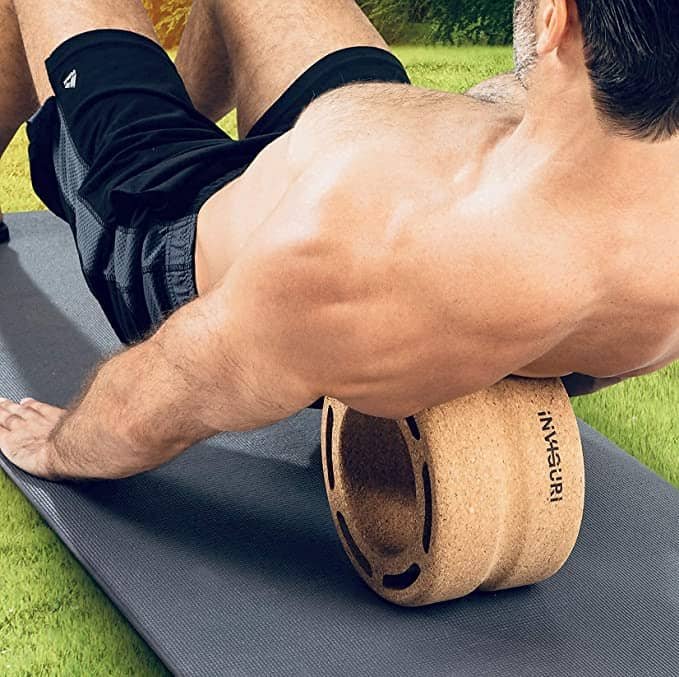

If you prefer a more active yet gentle spinal release, try using the yoga wheel to massage your back as you roll over it.
How to Do It:
- Start sitting on your mat and bend up your knees
- Place the yoga wheel at the base of your spine and lift your entire body on top of it
- With your hands and feet flat on the ground, use your legs to gently roll back and forth on the wheel as it massages away any tension
- If it is too intense, you can roll your mat or a yoga towel over the wheel for added cushioning
Benefits:
A wheel-assisted massage is so nice that it doesn’t even feel like exercise. You can use the yoga wheel for a quick 5-minute release in the middle of the day and you’ll stand up feeling like you just got an expensive massage (for way cheaper of course). The rolling motion allows you to focus on certain areas of the back while simultaneously warming up the vertebrate and targeting pressure points.
Wheel-Assisted Fish Pose
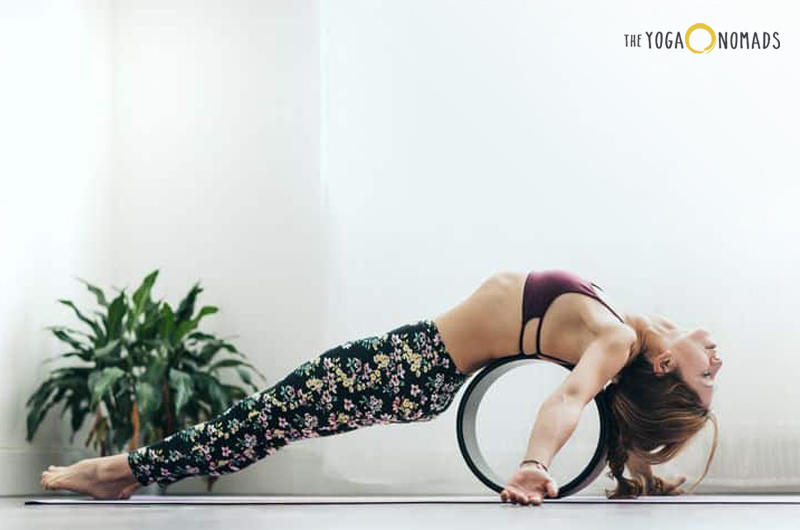

Fish Pose (Matsyasana) can be a little intimidating and even dangerous for inexperienced practitioners. But with a proper warmup and the assistance of a yoga wheel, it is so much safer and accessible. You may find yourself craving this back-opening pose in your yoga routine.
How to Do It:
- Start in a seated position with your legs extended in front of you
- Place the yoga wheel behind you and gently roll onto it, allowing your full upper body to drape back and open your heart toward the sky
- Exhale and release the neck and head, keeping the toes pointed and feet flat on the floor, letting the yoga wheel hold your full body weight
- You can reach behind your head and grab hold of the yoga wheel for a full backbend or extend your arms to the side for a more relaxed stretch
Benefits:
This simple backbend offers all the benefits of a heart-opening pose combined with a light inversion. It helps restore your mood, lengthen your spinal column, and relieve pressure between the shoulder blades. It is much safer and beginner-friendly than a standard fish pose.
Yoga Wheel Poses for Strength
Yoga Wheel Rolling Plank
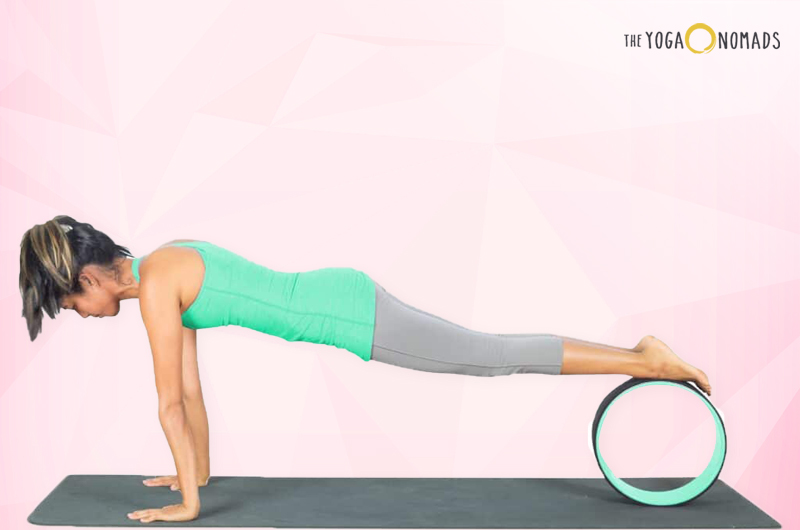

We all know plank position is the secret to a strong core, but this wheel-assisted version takes it to the next level by challenging your movement, focus, and balance. Your abs will be burning after a few sets of this!
How to Do It:
- Start in a tabletop position with the yoga wheel at the base of your mat
- Lift one leg and place the top of the foot on the wheel, then bring the other to meet it
- You should now be in a plank position with legs extended and feet on top of the yoga wheel
- On an inhale, roll the wheel forward with your knees bent and core engaged
- Hold for a few breaths and then roll it back to plank, repeating as many times as you’d like for a core strengthening challenge
Benefits:
Plank pose is known to help with balance and coordination while building core muscles and improving metabolism. It also strengthens your spine and your upper body. By adding the yoga wheel beneath the plank, you can make the plank dynamic for extra ab strengthening.
Wheel Lunge
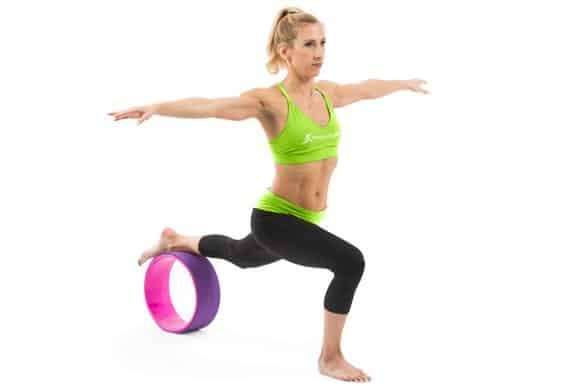

How to Do It:
- Start in a standing position with the yoga wheel near the back of your mat
- Place one foot on top of the wheel and extend your leg backward until your standing leg reaches a 90° angle lunge
- Keep the chest lifted and front leg bent with the front knee stacked above your angle just like a standard lunge
- Roll back and forth for an added quad stretch and conditioning
- Repeat on the other side
Benefits:
This wheel-assisted lunge is a great lower-body workout to strengthen your quads and glutes. Lunges are known to improve blood flow and joint mobility while adding a bit of balance challenge as well. The yoga wheel lets you flow in and out of lunges for a more dynamic workout that stretches and strengthens simultaneously.
Balancing Garland Pose
Garland Pose (Malasana) just got a whole more fun and interesting. Balancing on a yoga wheel is challenging, but not quite as hard as it looks. Because your toes are pointed outward, the wheel stays fairly stable and supports you as you make adjustments.
How to Do It:
- Begin with the yoga wheel in front of you and slowly lift your left leg onto the yoga wheel
- Adjust your foot outward to the shape of the wheel as you step your right leg onto the wheel, allowing your butt to reach downward and your knees to point outward
- Bring your hands to the heart center and press lightly against your sternum to help with balance
- Try to keep your lower back straight and open your chest upward as you look directly forward and activate the inner legs
Benefits:
Malasana is very beneficial for your pelvic region, especially in pregnant women. This position challenges your balance while opening up the hip flexors and groin. It also strengthens the inner thighs, increases blood flow, and improves colon health.
Wheel Pike
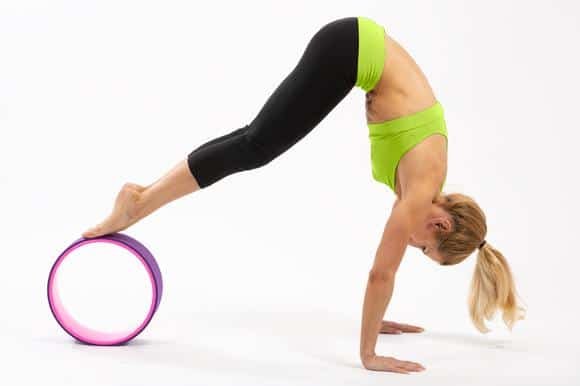

As you can tell from the previous pose that targeted the core, a yoga wheel is especially great for challenging your abs and making asanas more active. This wheel pike-plank pose will raise your heart rate and tone your abdominal muscles.
How to Do It:
- Start in a tabletop position with feet hip-width distance and wrists aligned beneath the shoulders
- Draw in your lower stomach and lift one leg at a time onto the wheel, adjusting until the top of your shins are on the wheel and you are in a plank position
- Begin rolling the wheel forward and shifting your weight more into your hands
- Your glutes will reach toward the sky in an inverted “V” shape with major core engagement
- Careful not to curve your back or let your hips sink down
- Breathe with your movements and continue rolling the pike forward and backward with contracted abs and strong arms
Benefits:
A stronger core helps prevent back injuries and adds stability to the front body. The wheel pike in particular prepares your core for inversions and handstands, as well as support in prolonged seated positions. The crunching motion can also stimulate digestion.
Wheel-Assisted Crow Pose
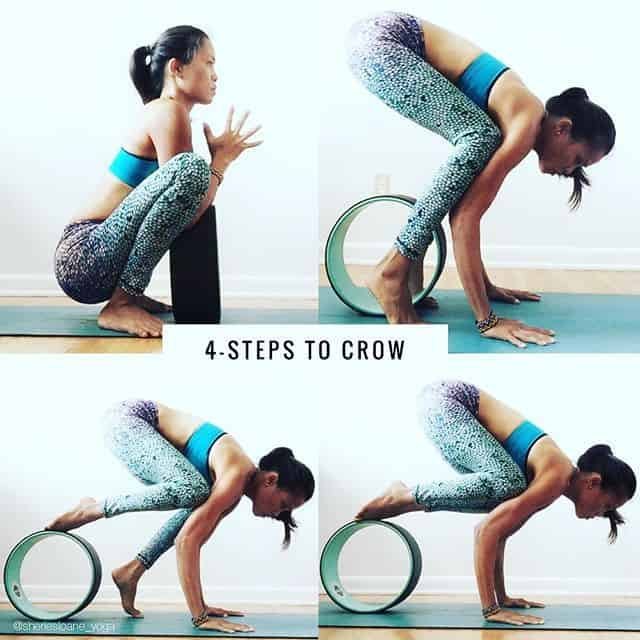

If you’re anything like me, you’ve been trying Crow (Bakasana) for years and never quite got there. A yoga wheel is what will finally make this pose possible for you while also preparing you for a future wheel-free expression of this fun balancing asana.
How to Do It:
- Start in a seated Malasana pose with your toes pointed outward, knees bent, and butt squatted to the floor
- Move your hands shoulder-width apart and place the yoga wheel between your legs
- Begin engaging your core and shifting your knees into your armpits, resting the shins on the back of your triceps
- Lift one foot onto the wheel and then the other, keeping the toes pointed and the top of the foot lifted off the wheel
- Practice moving the wheel around as you shift your body weight forward into your arms, eventually lifting your toes off the wheel altogether
Benefits:
Bakasana strengthens your hands, shoulders, arms, abs, and thigh muscles. It requires mental strength as well to maintain the arm balance and focus. The yoga wheel can help you ease into the crow pose while still feeling supported and elevated. It is perfect for mastering the form, strength, and alignment as you slowly work toward the full expression.
The Importance of Safety and Efficiency When Incorporating a Yoga Wheel
When delving into the realm of yoga wheels, it is crucial to address safety.
Prioritizing Safety
Using a yoga wheel may seem exciting. Indeed, it is. However, similar to yoga props, it is essential to use them. Begin slowly. Refrain from attempting poses right from the start.
Take the time to familiarize yourself with your wheel, understanding how it moves and provides support. This approach helps prevent injuries.
Listen to Your Body
Your body holds wisdom. If a pose doesn’t feel right, pause and reassess. Yoga isn’t about pushing past discomfort; rather it focuses on cultivating balance and strength with gentleness.
The purpose of the yoga wheel is to assist you, not cause harm. Therefore, if your body signals discomfort during a backbend, heed its warning. There are always poses for exploring.
Effectiveness
Now why should one incorporate a yoga wheel into their practice? It surpasses being a passing trend; this tool introduces dimensions to your yoga routine. It enhances stretches.
Engages muscles, in ways while also rendering challenging poses more achievable. Have you ever aspired to master that flawless backbend? The yoga wheel becomes your ally in achieving that goal.
In brief, the connection, between safety and efficiency is crucial when incorporating a yoga wheel into your practice. Prioritize safety, from the beginning. You’ll soon realize the impact this prop can have on enhancing your yoga routine.
Yoga Wheel for Mindfulness and Meditation
When we talk about yoga wheels we often focus on the advantages and challenging poses they offer.
Mindfulness Practice with a Yoga Wheel
Integrating a yoga wheel into your mindfulness routine can bring a level of awareness. For example, just sitting on the yoga wheel can help enhance your posture making you more mindful of how your spine is aligned.
This heightened physical awareness can open the door to mindfulness as you concentrate on your breathing and bodily sensations.
Meditation and the Yoga Wheel
Incorporating the yoga wheel into your meditation practice can also elevate your experience. Placing the wheel beneath your knees while sitting can alleviate pressure on your hips and lower back enabling you to sit for periods.
This physical ease can facilitate a meditation session by eliminating distractions caused by bodily discomfort.
I’ve noticed that feeling the pressure of the yoga wheel against my body acts as a nudge to bring my focus back, to the present whenever my thoughts start drifting away.
It’s a powerful tool that nurtures both the body and the mind.
In a society where yoga routines frequently focus on the aspects incorporating a yoga wheel into mindfulness and meditation serves as a reminder of the comprehensive essence of yoga. It goes beyond postures; it involves fostering a profound bond, with our inner selves.
How to Select the Perfect Yoga Wheel
Consider the Material
When picking out a yoga wheel, the material plays a significant role. Yoga wheels are commonly crafted from plastic, cork, or wood. Plastic wheels are light and sturdy, making them convenient for travel. Cork wheels offer an eco-friendly choice and a softer, cushioned feel. Wooden wheels are known for their durability and ability to bear more weight, although they can be heavier. Think about your specific requirements and preferences when deciding on the material.
Size and Diameter
Yoga wheels are available in various sizes, typically ranging from 6 to 13 inches in diameter. Smaller wheels work well for targeted muscle work and beginners seeking more control. Larger wheels are suitable for deep backbends and taller individuals. Consider the poses you intend to practice with the wheel and select a size that suits your body size and preferred practice style.
Weight Capacity
Before making a purchase, check the weight capacity of the yoga wheel. Most high-quality wheels can handle up to 500 pounds, but it’s wise to verify this information beforehand. A wheel with a higher weight capacity will be more resilient and offer better support during challenging poses.
Padding and Comfort
The padding on a yoga wheel can greatly impact comfort.
When selecting a yoga wheel, opt for one with thick, dense foam padding to protect your spine and joints. Some wheels also feature a textured surface for improved grip, especially useful during intense workouts.
Consider both the pricing and brand when making your choice. While going for the cheapest option may be tempting, investing in a well-known brand can ultimately save you money. High-quality yoga wheels are more resilient and offer better support. It’s advisable to read reviews and assess the brand’s reputation before finalizing your purchase.
Picking the right yoga wheel can elevate your practice and bring various advantages. Take some time to evaluate these factors to discover the ideal wheel that suits your requirements.
The Benefits of Using a Yoga Wheel for Your Well-Being
Improving the Connection Between Body and Mind
Using a yoga wheel goes beyond just physical advantages. It also helps greatly in enhancing the connection between your body and mind. By integrating a yoga wheel into your routine, you become more mindful of how your body aligns and moves. This increased awareness can result in a deeper and more focused practice.
Alleviating Stress and Anxiety
The gentle, rolling movements and supported stretches facilitated by a yoga wheel can aid in reducing stress and anxiety. The wheel allows for a more calming practice, which can activate the body’s restorative functions through the parasympathetic nervous system, ultimately helping to decrease stress levels.
Building Confidence
Achieving mastery over new poses with the assistance of a yoga wheel can boost your self-assurance. The wheel offers the necessary support to try out more challenging postures, giving you a sense of accomplishment and drive. This feeling of success can positively impact various aspects of your life, enhancing overall confidence.
Enhancing Mental Clarity
The focus required to balance and align your body on a yoga wheel can enhance mental clarity. This level of concentration aids in quieting the mind, making it easier to enter into a meditative state.
Over time, practicing this can enhance your focus and clarity in daily tasks.
Promoting Emotional Release
Certain yoga wheel poses, such as heart-opening poses, can facilitate emotional release. These postures aid in releasing stored emotions and tension, fostering a feeling of emotional liberation and overall well-being. The physical act of opening up can symbolize an emotional release, offering a comprehensive approach to health and well-being.
Integrating a yoga wheel into your routine provides more than just physical advantages. It can improve your mental and emotional wellness, serving as a valuable asset for a well-rounded yoga practice.
Pop quiz! 🧘🤔
A yoga wheel can only be used by advanced yogis.
Yoga wheels help improve flexibility and reduce back pain.
Using a yoga wheel can make balancing poses more difficult.
FAQs
Is a yoga wheel worth it?
A yoga wheel may be the best prop you can invest in for your yoga practice. It is more versatile than a block or bolster, and more dynamic than a foam roller. Yoga wheels help improve posture, relieve back pain, strengthen your core muscles, and challenge your balance.
Is a yoga wheel good for beginners?
Yoga wheels are the perfect yoga prop for beginners because they let you practice backbends and heart-opening poses with less risk of injury. The wheel supports your spine as you lengthen and stretch, while simultaneously massaging out the kinks with each rolling motion.
What muscles does the yoga wheel work?
Depending on what pose you attempt, a yoga wheel can work your back, core, arms, or leg muscles.
How do you practice with a yoga wheel?
A yoga wheel can easily be incorporated into any yoga practice through modified poses such as fish pose, wheel-assisted crow, plank pose, backbends, and child’s pose. Whether holding the wheel in your hands or laying your spine back on it, this prop helps improve flexibility and reduce injuries.
Is a yoga wheel better than a foam roller?
Yoga wheels are far more versatile and supportive than a foam roller. They tend to be more rigid and specifically shaped for rolling along the spine. You can use a yoga wheel with over 100 different asanas for strengthening, pain relief, flexibility, and conditioning of many types. A foam roller just doesn’t live up to the benefits of a yoga wheel.
Thanks for your feedback!




